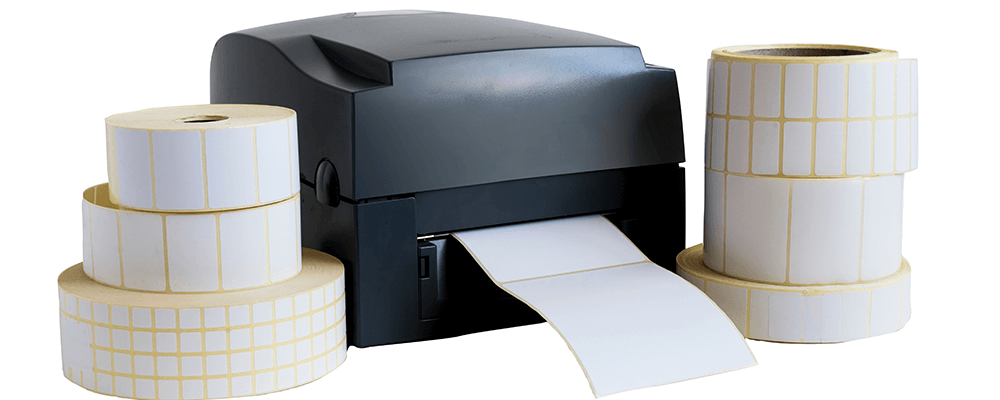How Thermal Printers Work: A Simple Guide to Thermal Labels

Thermal printers are a popular choice for businesses that need to print labels, receipts, and barcodes. They’re fast, efficient, and don’t require the use of ink or toner, making them cost-effective for many industries.
But how do thermal printers work, and what makes them different from other printers? In this guide, we’ll explain how thermal printers function and help you understand the differences between direct thermal labels and thermal transfer labels. We’ll also answer the common question: does a thermal label printer need ink?
How Do Thermal Printers Work?
A thermal printer works by applying heat to a special type of paper or label, which reacts to the heat and creates the print. Instead of using ink or toner, these printers rely on heat-sensitive materials to generate images or text. There are two main types of thermal printing methods: direct thermal printing and thermal transfer printing.

Direct Thermal Printing
Direct thermal printers don’t use any ink, toner, or ribbons. Instead, they use heat-sensitive direct thermal labels. These labels are coated with a special material that turns black when exposed to heat. As the printhead heats up specific areas of the label, the desired text or image is created.
This method is simple and doesn’t require many supplies, which is why it’s often used for things like shipping labels and receipts. However, direct thermal labels are sensitive to light, heat, and friction, which can cause them to fade over time.
- Best For: Short-term labels, like shipping labels or receipts.
- Pros: No need for ribbons, ink, or toner.
- Cons: Labels may fade quickly when exposed to heat, light, or friction.

Thermal Transfer Printing
Thermal transfer printers, unlike direct thermal printers, use a ribbon coated with ink. When the printhead heats up, it melts the ink from the ribbon onto the label, creating a durable image. This method works on a wide range of label materials, including paper, polyester, and polypropylene.
Thermal transfer labels are more durable than direct thermal labels and are often used for products that need long-lasting labels, such as asset tags, product labels, and barcode labels in warehouse settings.
- Best For: Long-lasting labels, product packaging, barcode labels.
- Pros: Produces durable labels that can resist fading, moisture, and chemicals.
- Cons: Requires a ribbon, which adds to the cost and maintenance.
Does a Thermal Label Printer Need Ink?
One of the most common questions is, does a thermal label printer need ink? The answer is no—thermal printers do not use traditional ink cartridges. Instead, they rely on heat to create prints.
- Direct Thermal Printers: Don’t need ink or ribbons. They use heat-sensitive direct thermal labels to create the print.
- Thermal Transfer Printers: Don’t use ink but require a ribbon. The ribbon contains a layer of ink that transfers to the label when heated.
In both cases, there’s no need to buy or replace ink cartridges, making thermal printers a cost-effective option for businesses that print a lot of labels.

What Kind of Labels Do Thermal Printers Use?
Thermal printers typically use two types of labels: thermal transfer labels and direct thermal labels. Let’s break down each type:
- Direct Thermal Labels: These labels are heat-sensitive and turn black when exposed to heat. They’re best for short-term use, as they can fade over time, especially when exposed to heat or sunlight. They are ideal for printing receipts, shipping labels, or any labels that don’t need to last a long time.
- Thermal Transfer Labels: These labels are more durable and are printed using a ribbon that transfers ink onto the label. They can handle exposure to sunlight, moisture, and chemicals, making them suitable for long-term product labels, outdoor applications, or warehouse labeling.
Blank labels for thermal printers come in a variety of sizes, materials, and shapes, allowing businesses to choose the right label for their specific needs.
Advantages of Using Thermal Printers
Thermal printers are widely used across different industries for a number of reasons. Here’s why they’re a popular choice:
- No Ink or Toner: As mentioned earlier, thermal printers don’t require ink or toner, which cuts down on supply costs.
- Fast and Quiet: These printers are quick and quiet, making them efficient for high-volume printing tasks like labeling products or printing receipts.
- Low Maintenance: With fewer parts that need replacing (no ink or toner), thermal printers require less maintenance compared to traditional inkjet or laser printers.
- Durable Labels: Especially when using thermal transfer labels, thermal printers can produce labels that last for a long time, even in tough environments.
FAQ: Thermal Printers
Q: How do thermal printers work?
A: Thermal printers use heat to create prints. Direct thermal printers use heat-sensitive labels, while thermal transfer printers use a ribbon to transfer ink onto labels.
Q: Does a thermal label printer need ink?
A: No, thermal printers do not use ink. Direct thermal printers only need heat-sensitive labels, and thermal transfer printers use a ribbon instead of ink cartridges.
Q: What’s the difference between direct thermal labels and thermal transfer labels?
A: Direct thermal labels are heat-sensitive and don’t need a ribbon but can fade over time. Thermal transfer labels use a ribbon for printing, resulting in longer-lasting and more durable labels.
Q: Can I use blank labels with a thermal printer?
A: Yes, you can use blank labels with both direct thermal and thermal transfer printers. Just make sure to choose the right type of label for your printing needs.
Understanding How Thermal Printers Work
Thermal printers are a reliable, cost-effective solution for printing labels, receipts, and barcodes. Whether you need thermal transfer labels for durable, long-term use or direct thermal labels for short-term applications, these printers offer flexibility and efficiency. And best of all, there’s no need to worry about ink or toner!
Need help finding the perfect labels for your thermal printer? Contact us today for advice on thermal labels, blank labels, and more!


